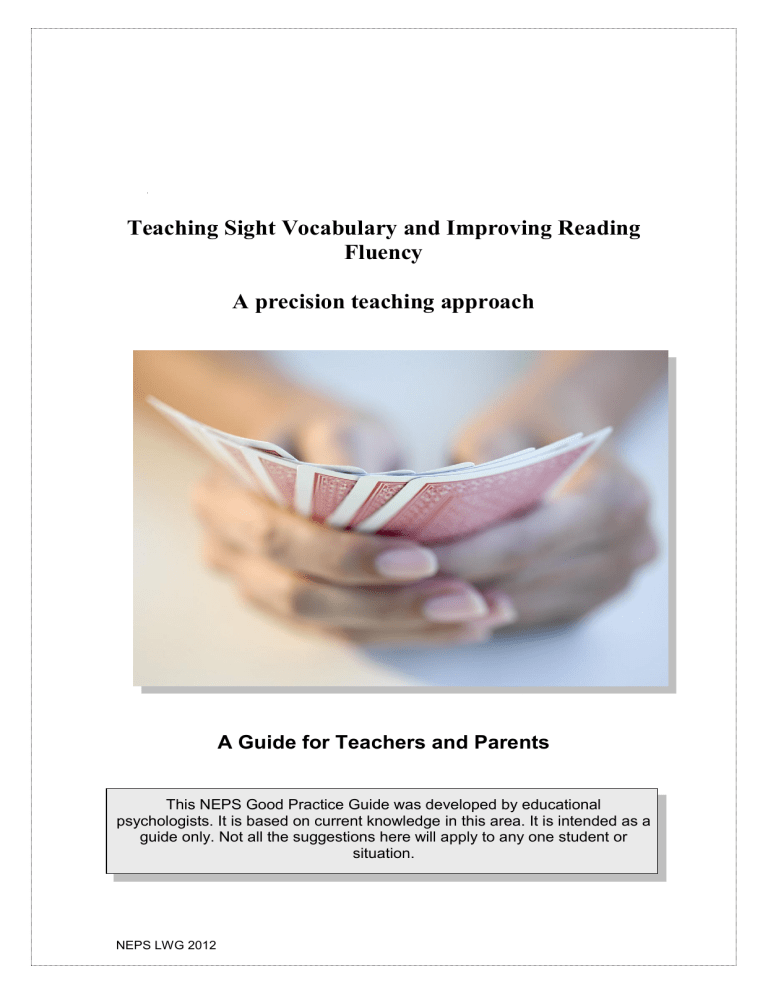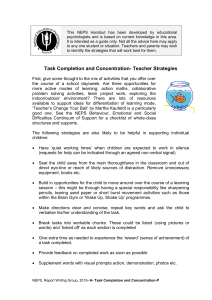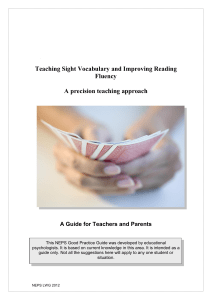
Teaching Sight Vocabulary and Improving Reading Fluency A precision teaching approach A Guide for Teachers and Parents This NEPS Good Practice Guide was developed by educational psychologists. It is based on current knowledge in this area. It is intended as a guide only. Not all the suggestions here will apply to any one student or situation. NEPS LWG 2012 A Precision Teaching Approach to Teaching Sight Vocabulary and Improving Fluency It is important when working with children that they read at a level that is called proficiency level. This means they can read material at a 95% accuracy level. Outlined below is a method that will support you to achieve this proficiency level. It is a precision teaching method although precision monitoring may be a better term to use as it monitors precisely learners‟ progress in acquiring sight vocabulary. It is about building a sight-vocabulary using a visual method. This is learning to read words by looking at them and remembering them, rather than sounding them out. 1. Establishing target words To start precision teaching one needs to identify where the learner is in relation to either their current class reader or dolch list, textbooks, Jolly Phonic „tricky‟ words or any list of key sight words being taught. Establish where they are by checking the number or words which they can automatically recognise. (Automatic recognition is different to decoding. It means the learner instantly recognises the word as a whole word and does not hesitate or sound out the word). Provide the student with a copy of the list of words you wish to check and keep a copy for yourself. Ask the student to read down the list and tick off the words he/she can read instantly (see sample list below). The unrecognised or hesitantly read words will form the student‟s longer term target list. Select a short term list of words as a target for your student to learn. This can vary depending on the age and ability of the student but is typically 4 to 6 new words. This can be increased or decreased depending on the rate at which the student learns. 2. Teaching Strategy Following the identification of the target words you then select appropriate teaching strategies. We have given one example below of a teaching strategy, which is based on a direct instruction method. This teaching approach can also be delivered by a parent, peer or a community volunteer under teacher direction and demonstration. Step 1 Print the short term target words onto card. (This can be varied for older students as flashcards may seem a bit childish for them. Perhaps use PowerPoint to teach new words). Do not use capital letters unless the word starts with a capital letter. NEPS LWG 2012 Try not to use card that is too big as it will be cumbersome to store. Make sure you use the same colour and size of card and same colour marker so there is no other way for the pupil to recognise a word. For example a student may know that the green word is home, as opposed to recognising home as a sight word. Avoid putting similar looking words together as this can make learning harder for students e.g. home and house or their and they. Place each card on the table one at a time and say the name of the word e.g., “this is the word shop”. Ask the learner to put the word into an oral sentence. If they have difficulty with this, give them an example and get them to repeat your example or give their own sentence. (Remember if a student doesn‟t know or understand a word they shouldn‟t be learning to read it). Repeat this process with all the target words. Step 2 When all the cards are on the table say the following to the pupil, “Point to the word shop”. The student must look at the word, putting their finger under the first letter of the word and say the word at the same time. Then say, “Point to the word home……” Continue like this for about 10 or 15 times, moving between the words. Getting the student to place their finger under the first letter cues them into the starting phoneme of the word and keeps them focussed on the word. This is can be done in a fun manner, or as a game. Younger students usually enjoy being told, “Let‟s see if I can catch you out”. This allows the student lots of practise to name the word without putting an expectation on the student to recognise the word from his/her own memory. Step 3 The next step is to pick up the cards and shuffle them. Place the cards down in a random fashion and ask the student to name the word. Usually students have no difficulty with this. Repeat this process 3 or 4 times. It may seem tedious but is the essential learning part of the method. 3. Monitoring and charting progress Following this teaching segment the teacher administers a one minute speed test known as a „probe‟. The probe consists of the words the child has just been taught. The probe gives information on the pupil‟s accuracy and fluency. Probes are constructed by preparing a list of words just taught, which are repeated randomly. A simple user friendly probe generator is available from this website www.johnandgwyn.co.uk/probe.html . (Click on „smaller print version’ and then save it to your computer. A page will open with numbers 4 onwards, on the very bottom of the page. Click on the number of target words you want in your probe e.g. 4 or 5 or 6 etc. A page with a grid will appear. In each of the NEPS LWG 2012 red squares at the top of the page type one target word. The probe will automatically place the words randomly across the grid. An example of a probe sheet with five target words and aim rate is shown below). For the pupil to achieve sight word recognition at automaticity or fluency levels they have to read 50 words on the probe within one minute with no more than two errors. Each day following the teaching, the probe is administered and the pupil‟s progress is charted on a graph/chart until the pupil achieves the aim rate (50 words per minute with no more than 2 errors). Charts can be very motivating for students. To see a sample graph/chart click on www.eptoolbox.co.uk, then click on Precision Teaching on the left hand side. When the next page opens up click on Daily Recording Charts and a sample chart will open up. If the pupil‟s rate of reading is not improving after 3 days then the number of words being taught needs to be reduced. If after 8 days the pupil is not at or very near your selected aim rate then you may consider adapting your teaching strategy and reviewing your target words. Over successive days of practice, the data (corrects and errors) plotted on the chart produce learning pictures. When used effectively these learning pictures can indicate for each child, whether a task is too difficult, too easy or just right; whether the child requires further instruction, further practice, or should move onto to more complex tasks. Most importantly it indicates whether the teaching methods being adopted are having the desired effects. When the aim rate is reached a new set of target words is identified and the process is repeated again and again until the longer term targets can be read automatically. 4. Possible extension work The following steps are optional but provide extra extension work for students and link in with other key skills. Place all the words on the table again and ask the child to point to the word that starts with the sound /s/ or ends with the sound /s/. Pick other letter sounds or letter patterns e.g. /a/, –ing, -and etc. Some words that children are learning may have smaller words within them e.g. they, home, caravan. As an extra piece of work present words like these to the children one at a time. For example with the word caravan, cover the last four letters and ask the pupil, “What word do you see now? car, or cover the first four letters and ask the pupil, “What word do you see now? van. It doesn‟t matter if the child doesn‟t recognise the words, tell them or prompt them. This is just an exercise to develop their visual skills. If you do this every day they will soon start to see those smaller words. NEPS LWG 2012 A more difficult step from the previous one is to then ask the child to cover letters in the word caravan to show you car or van. Again don‟t worry if they can‟t do this, demonstrate for them each time. If possible supplement their daily learning with words they already know especially their name so sentences can be written with the words they have just been learning. 5. Maintenance Check It is very important to carry out regular „maintenance checks‟ of all target words over a six to eight week period. This involves re-visiting or re-checking the original long term target list of words. Generally pupils who have achieved this level of fluency maintain those words; however any words they haven‟t maintained can be included in the next list of target words. It is good practice at the beginning of each session to ask the student to read the words learnt previously. 6. Generalisation One of the potential difficulties of learning words that are not in context is that the pupil may not generalise their learning to written passages. Therefore, it is important to present the student with unseen passages that contain the target words to see if he/she can read the words fluently. That is the one advantage of taking the target words from a graded reading scheme. Alternatively teachers can compose passages of text which include the target words. References Chiesa, M., & Robertson, A. (2000). Precision teaching and fluency training: Making maths easier for pupils and teachers. Educational Psychology in Practice, 16 (3), 297-310. DfES. (2003) Desjardins, E. A., & Slocum, T.A. (1993). Integrating Precision Teaching with Direct Instruction. Journal of Precision Teaching, X (2), 20-24. Ikin, A.B. (2005). Precision teaching: The Standard Celeration Chart. The Behaviour Analyst Today, 6(4), 207-213. Raybould, E. C., & Solity, J. E. (1988). More Questions on Precision Teaching. British Journal of Special Education, 15(2), 59-61. NEPS LWG 2012 Sample list of words Jolly phonic tricky words Book 1 I the he me was to said she we do here are all you your come some there they go by like no so my one have live give shoe the three tricks two at can did do four glasses her his lollipop look on play see you NEPS LWG 2012 Book 2 an apple banana beans blocks books box bread carrots cheese chips dog eating everything favourite food fruit has He lots meat milk no of pets pizza reads she teddy toast toys vegetables with yogurt Sample probe sheet with five target words said you we the of you the of we said we of you said the you said the of we the we said you of said of the we you of said we you the you the we said of NEPS LWG 2012 Word Probe Sheet Name of child: ________________________________ Baseline: _____________________ Date: _____________ Target: ______________________ Date: _____________ Date: Words: NEPS LWG 2012 Precision Teaching Approaches and Using SNIP SNIP is a resource pack aimed at increasing the reading ages of pupils with reading ages of 10+. It includes curriculum words and words that often contribute to reading hesitation and are irregular i.e. not phonic. The packs are intended to be photocopied and a new one given weekly to students who practise them daily and are then timed on their ability to read them out loud. How the reading practice is organised depends on the organisation of each school – some may be able to involve parents, adult helpers and peers, but it is also important to encourage the pupils themselves to practice unaided in order to allow them to gain fluency and control over the process. SNIP Precision Teaching Pack (credit Carol and Phil Smart) www.snip-newsletter.co.uk This is a free download. Sample from SNIP Word Monday guard height queue straight weird strength weight NEPS LWG 2012 Tuesday Wednesday Thursday Friday Checklists for the First Hundred Words, Second Hundred Words and Phonics These resources have been developed by NEPS to assist teachers who wish to check a student‟s knowledge of sight words or phonics. They allow for teaching and review of progress and may be particularly suited to using with a precision teaching approach. Click here to download these checklists There are also extensive resources freely available on www.theschoolbell.com. Once on this site look at the material labelled Dolch kit. It allows you to make really attractive booklets with sight words set out in 11 lists. There are, of course, many other ways of teaching sight vocabulary, including teaching vocabulary works in advance of meeting them in text. Teaching sight vocabulary is only one element of a balanced approach to literacy and should form part of a coherent approach to literacy skills. NEPS LWG 2012 NEPS LWG 2012 NEPS LWG 2012 NEPS LWG 2012 NEPS LWG 2012 NEPS LWG 2012 NEPS LWG 2012 NEPS LWG 2012


